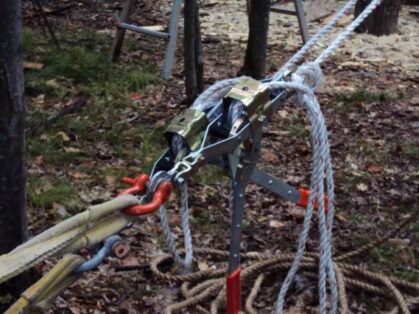It is not uncommon to have a tree that is tilting. Of course, our reflex is to want to straighten it immediately, but how? It should be mentioned at the outset that not all trees can be straightened. In fact, it is prevention that should be advocated, because once a tree has reached a certain maturity, we cannot straighten it.
The reasons for wanting to straighten a tree can vary, with aesthetics being a fairly important issue. Aside from aesthetics, it may be safety that is threatened by the tree tilting, especially if there is a large structure underneath the tree.
Contents
How do you prevent a tree from tilting?
The first advice is tutoring, but in moderation. Under optimal conditions, with a well levelled ground and moderate winds, a tree would not need a stake. Indeed, the movements of the tree caused by the wind stimulate the tree to better anchor itself in the ground. The stake is therefore a double-edged sword: as much as it can prevent a tree from tilting, it can also make the tree lazy in terms of its development and solidity.
This is why it is recommended not to exceed a threshold of two years, after which the stake should be removed. Neglecting this time limit will weaken the tree and eventually make it more vulnerable to the wind, and it will then be in danger of leaning.
Straightening an average tree after uprooting
During the fall, the tree’s anchor roots may have failed or been pulled to the surface. In any case, their recovery is not immediately possible and will take several years.
Prop up the tree
To support the trunk, prepare at least 3 props with wide planks.
- Cut the planks: using a saw, cut an arc slightly wider (2-3 cm wider) than the diameter of the trunk or low branches.
- If possible, dig a trench at the crown, otherwise closer to the trunk.
- If you have a solid anchor point, use 1 or 2 strong come-along to try to straighten the trunk.

What’s a come-along?
The come-along is a manual winch with a passing cable. It is a lightweight tool that allows heavy loads to be moved with less effort, without the use of a vehicle or crane. It can be used for :
- uprooting a stump ;
- move a trunk (skidding), a rock, a caravan or a shed ;
- guiding a tree in its fall to ensure the safety of the property around it;
- lifting a load (a hoist is often more suitable).
- It is relatively simple to use, provided certain precautions are taken. It is operated by means of a lever operated by one person, or even two if necessary.
-
Choosing your anchor point
In nature, a large, healthy tree is often used as an anchor:
- Surround the trunk with a chain pant or polyester strap (less aggressive for the trunk) so as not to damage the cable of the come-along.
- Protect the bark, such as by inserting planks between the chain and the trunk.
- If the anchor tree is the same size as the tree to be pulled out (e.g. a hedge from which you want to pull out all the trees), place the pantoire lower on the anchor tree.
Choose another type of anchor point
Other anchors can be used to fix the anchor bolt:
- a crowbar well embedded in the ground ;
- a sealed post;
- or the hook of a well-secured vehicle.
Important: Regardless of the type of anchoring point used, make sure to choose a sufficient cable length and thickness for the intended use. In particular, use a cable with a diameter of at least 11 mm and a length of at least 20 m for the removal of moisture.
-
Activate the come-along
- Make sure that the space between the secured object and the anchor point is evacuated. Keep people away to avoid accidents.
- With work gloves on, in the upright position, activate the come-along lever forward and backward.
- Good to know: each round trip increases the cable by 15 to 30 cm depending on the model.
- Remain vigilant throughout the operation.
Summary
The come-along, takes up little space and is quick to operate, and develops considerable force. Its only constraint: to have an anchoring point that is stronger or heavier than the load to be pulled.









